Quick search
CTRL+K
Quick search
CTRL+K

Leipzig is a city with long and proud traditions in trade. It was here that the trade routes Via Regia and Via Imperii crossed each other, thereby connecting most of Europe through Leipzig. Trade created a wealthy city, which for a period was also one of the European strongholds for culture and education.
There are many beautiful and impressive buildings in Leipzig, where you can enjoy architecture from many eras. The city’s old town hall stands as one of Germany’s finest Renaissance buildings, and you can also see fine examples from the Baroque and later architectural styles, not least from historicism.
In Leipzig you should visit the city’s two main churches, the Nikolaikirche and the Thomaskirche, and you can also see the Paulinum as an exciting mix of an old church and modern architecture. Markt is the city’s central square, and close to it is Augustusplatz with the Leipzig Opera. The city’s many arcades and passages are also distinctive features.
In the outskirts of Leipzig you can visit the colossal monument, the Völkerschlachtdenkmal, and in the vicinity of the city there are many cities of rich culture such as Halle and Erfurt and a beautiful nature as well. A trip to the south-eastern part of the Harz mountain range is just one of the great options for a day trip.
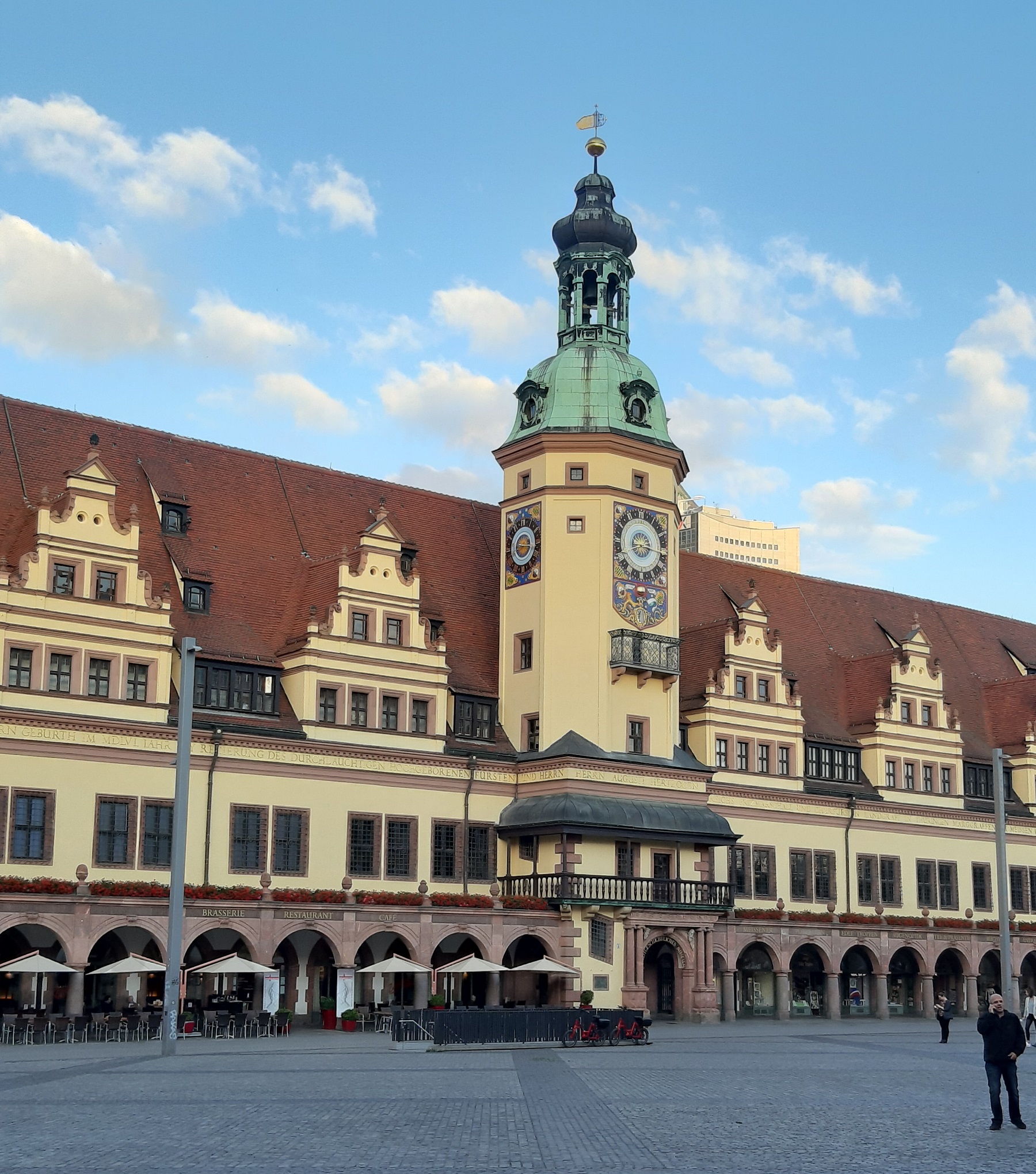
Altes Rathaus is Leipzig’s old town hall, located on the inner city market square. It was built in 1556-1557 and stands as one of Germany’s finest secular buildings from the Renaissance era. The town hall building was used as the seat of the city government until the current town hall was completed in 1905. The large Festsaal in the building is 43 meters long and was previously used for celebrations for the Saxon princes, for weddings of the bourgeoisie, large balls, etc.
The old town hall is a landmark for Leipzig, and you can visit a city history museum in the beautiful setting. The permanent exhibition describes Leipzig and conveys the city’s history from the Middle Ages to the present day. On a visit you can of course also see the town hall building itself and its interior, from the remains of old prison cells in the basement to the historic rooms on the main floor and the fine tower of the town hall.
Mädler-Passage is the best known of Leipzig’s fine old arcades, where shops and restaurants are located in beautiful settings under the glass covers of the interior streets. Auerbachs Hof was located on this site from 1530 to 1912, where the manufacturer Anton Mädler bought the old merchant house, which he demolished to make way for the Mädler Passage, which was built in 1912-1914.
It was Theodor Kösser who designed the shopping arcade for Anton Mädler. The arcade was built as a 142 meter long passage through a five-storey building. The arched portal at the entrance is flanked by two life-size female figures standing in robes, carrying grapes and a vase as a reference to the house’s purpose as a wine cellar named Auerbachs Keller. Among the fine interiors, you can see a carillon made of Meissen porcelain in the passage’s rotunda.
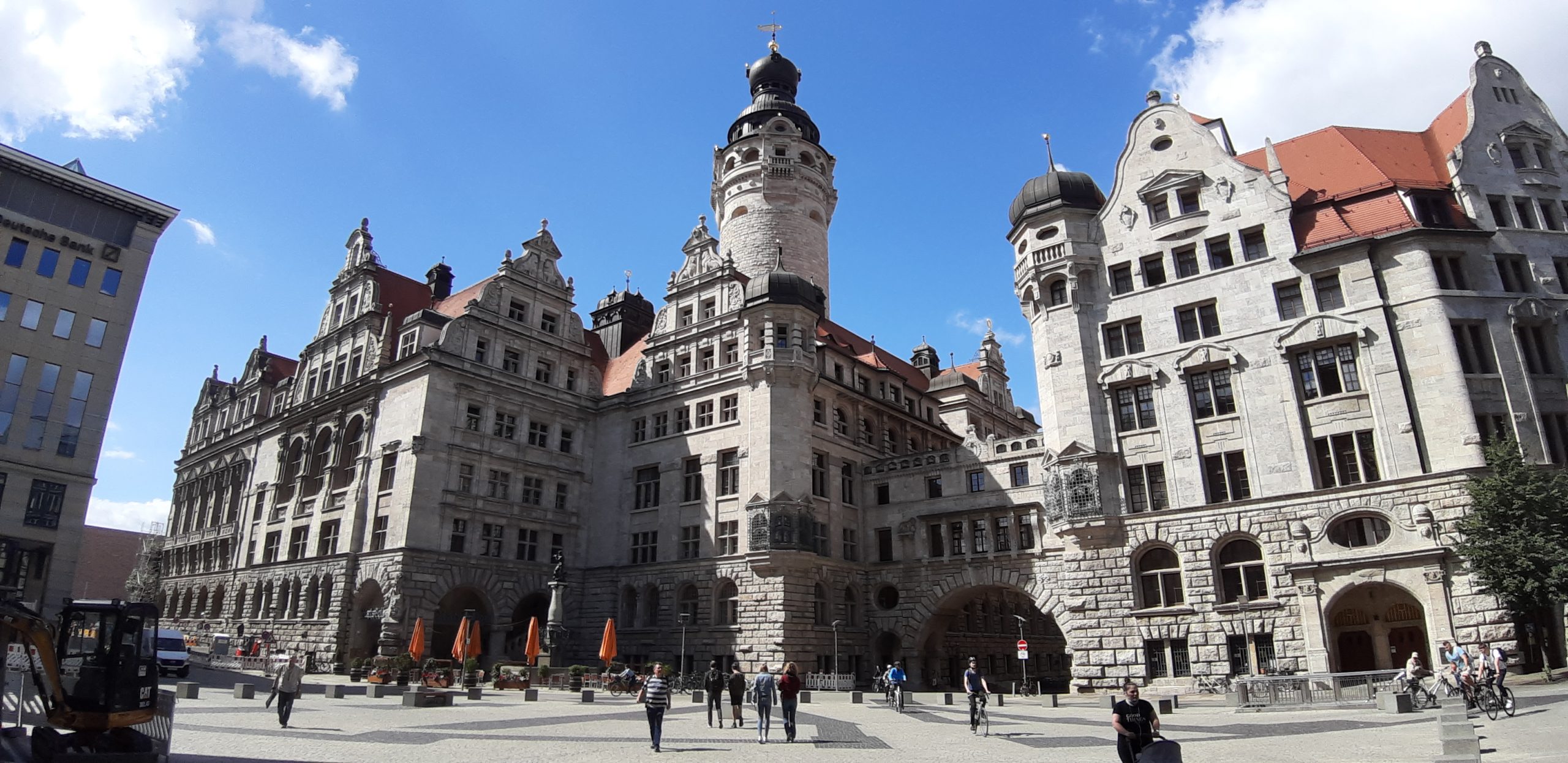
Neues Rathaus is the current town hall in Leipzig and thus home to the city’s mayor and city council. The large town hall is located in the south-eastern part of the center of Leipzig, where it opened in 1905. It was built almost like a colossal castle, and the 115 meter high tower is Germany’s tallest town hall tower. The historicist architecture was inspired by the castle Pleißenburg, which was located on this very spot before the town hall was built.
The town hall history began at the end of the 19th century, when the then town hall on the Markt square became too cramped for the administration of the growing city. In 1895, the Kingdom of Saxony provided a plot of land for the city, and an architectural competition was launched for the new building. In the competition, there was a condition that Pleißenburg’s tower, Rapunzelturm, should somehow be included in submitted proposals. Hugo Licht won the competition and the foundation stone for his town hall design was laid in 1899.
The architecture was inspired by Pleißenburg’s castle-like silhouette, and the town hall tower was built on the foundation of the earlier tower. There are several details worth noting. These include the five statues representing craft, justice, books, science and music, which the artists Arthur Trebst, Johannes Hartmann, Adolf Lehnert, Josef Mágr and Hans Zeissig created, and which can be seen on the south-west facade. You can also see impressive halls in the large building.
Auerbachs Keller is one of Leipzig’s oldest and probably most famous restaurants. The cellar is located under the similar worth-seeing Mädler-Passage, and its history goes back to a wine bar in the 15th century. Today, there are several beautiful dining rooms in the restaurant, which became famous in earnest from Johann Wolfgang von Goethe’s Faust as the first place Mephistopheles takes Faust on their travels.
The wine bar was mentioned as early as 1438. The restaurant got its current name after the former builder and owner Heinrich Stromer. He was a city councilor in Leipzig, a doctor and university professor, and he was known as Doktor Auerbach, which was the name of his hometown. Stromer worked as chancellor of the university in 1508, and in 1519 he bought a property on which from 1530 he built Auerbachs Hof, which was on the site until 1912.
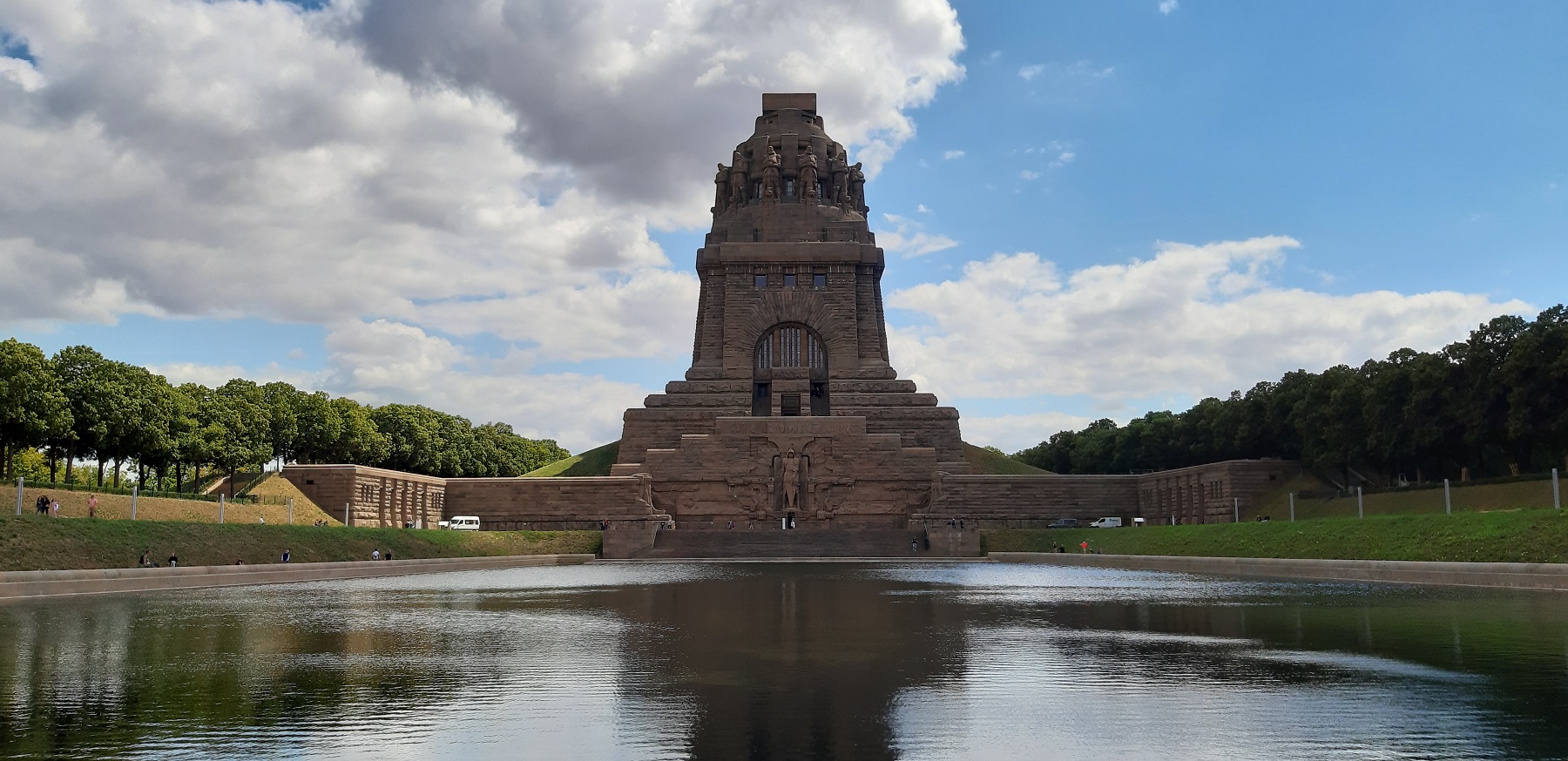
Völkerschlachtdenkmal or The Monument to the Battle of the Nations is a memorial that stands in the area southeast of the center of Leipzig, and it is one of Western Europe’s largest memorials. The 91 meter high monument was inaugurated in 1913 to commemorate the Battle of Leipzig, which took place on 16-19 October 1813, and which is called Völkerschlacht bei Leipzig in German. In the battle, Napoleon’s troops fought against armies from Prussia, Russia, Sweden and Austria.
The Monument to the Battle of the Nations was constructed on the site where the fiercest fighting took place and where most soldiers fell during the battle of 1813. In total, approximately 600,000 soldiers fought, of which around 90,000 fell. The battle ended in French defeat, and in the area of the later memorial, Napoleon decided to retreat.
There were many proposals for a memorial throughout the 19th century, and a foundation stone was laid in 1863. However, this was moved in 1900, when construction of the finally adopted project began. The memorial was then built in concrete and granite in a beautiful example of the German architecture of the time with features from the Art Nouveau style, but also other directions in an impressive historicist style.
The Völkerschlachtdenkmal was built on an artificial mound and a 60 meter long relief with scenes from the Battle of Leipzig was built into the front of the memorial. Here you can also see the archangel Michael as symbolic support for the German people. There are stairs leading up to the entrance to the monument’s crypt, marking the memory of those who fell in the battle. You can also climb to the top of the memorial, from where there is a beautiful view of the area and to Leipzig as well.
Thomaskirche is one of Leipzig’s two main churches, located in the city center. The church is worth seeing, and it is famous as the place where Johann Sebastian Bach was cantor in the years 1723-1750. You can see a monument to Bach in front of the Thomaskirche, where his grave has been since 1950. The monument was designed by the sculptor Carl Seffner and was erected in 1908.
There have been churches on this site since at least the 12th century. The current church was mainly built 1482-1496 as a neo-Gothic hall church. With the Reformation, Thomaskirche became Protestant, and Martin Luther preached here in 1539. In 1789, Wolfgang Amadeus Mozart played the organ in Thomaskirche during a tour, and Richard Wagner was baptized in the church in 1813. As a result, the church has been visited by several celebrities over time.
After the construction in the 15th century, the church interior had been rebuilt in Baroque style, which was, however, redecorated again in the 1880s. At that time, the church got its current Neo-Gothic interior. However, the Thomaskirche was partially rebuilt after destruction during World War II, when Leipzig’s Johanniskirche was also destroyed. Johanniskirche was later demolished and Bach’s grave was moved to the Thomaskirche on that occasion.
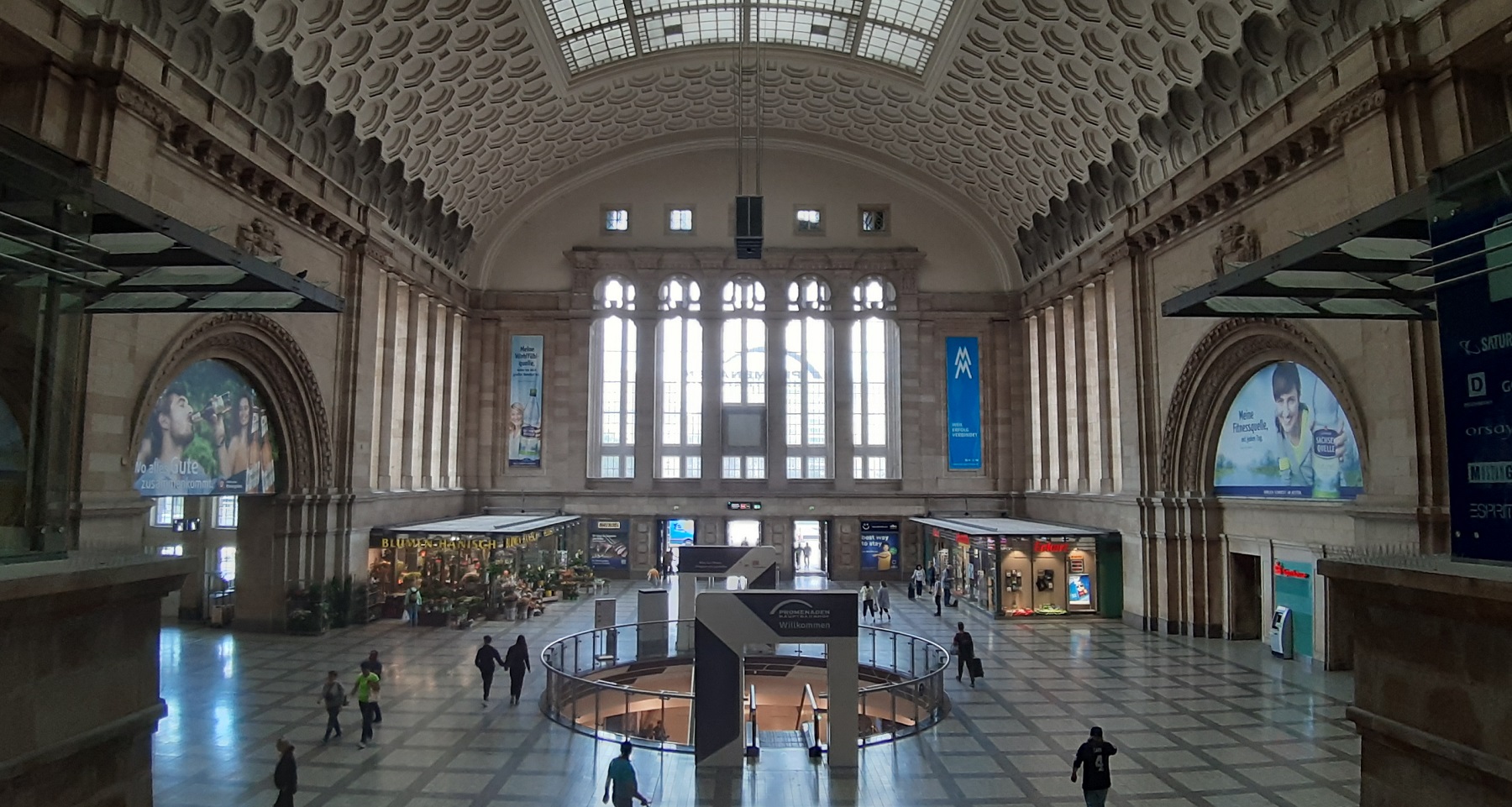
Leipzig Hauptbahnhof is a grand railway station that was opened in 1915 as Europe’s largest station. At the time, the city was at the center of the German railways, which stretched from Memel in the east to Metz in the west. There were 26 tracks in the platform halls and a colossal terminal building that continues to impress with its dimensions and decoration.
Leipzig developed rapidly as a railway hub after the opening of the Leipzig-Dresden line in 1839. Magdeburg-Leipzig was inaugurated a year later, and in 1842 train service between Leipzig and Hof started. In 1856, the Leipzig-Großkorbetha line was inaugurated, and it was later continued to Halle by the Thüringischen Eisenbahn company. There was therefore a lot of traffic to and from the city.
In the then northern outskirts of Leipzig, Dresdner Bahnhof, Magdeburger Bahnhof and Thüringer Bahnhof were built in close proximity to each other, while Bayerische Bahnhof, Eilenburger Bahnhof and Berliner Bahnhof were located elsewhere in the city. More tracks were added, and Leipzig’s population increased significantly throughout the 19th century and the beginning of the 20th century. The need for a new and unifying central station was urgent, and the foundation stone for Leipzig Hauptbahnhof was laid in 1909.
The platform halls and part of the station building were destroyed during American bombing in July 1944, but a reconstruction was carried out in the following decades. Today you can visit the railway station, which has an almost 300 meter long facade towards the center of Leipzig. You must make sure to visit track 24, which is a museum track with old equipment. Here, for example, you can see DRG SVT 137, which became known as the high-speed train of the 1930s.
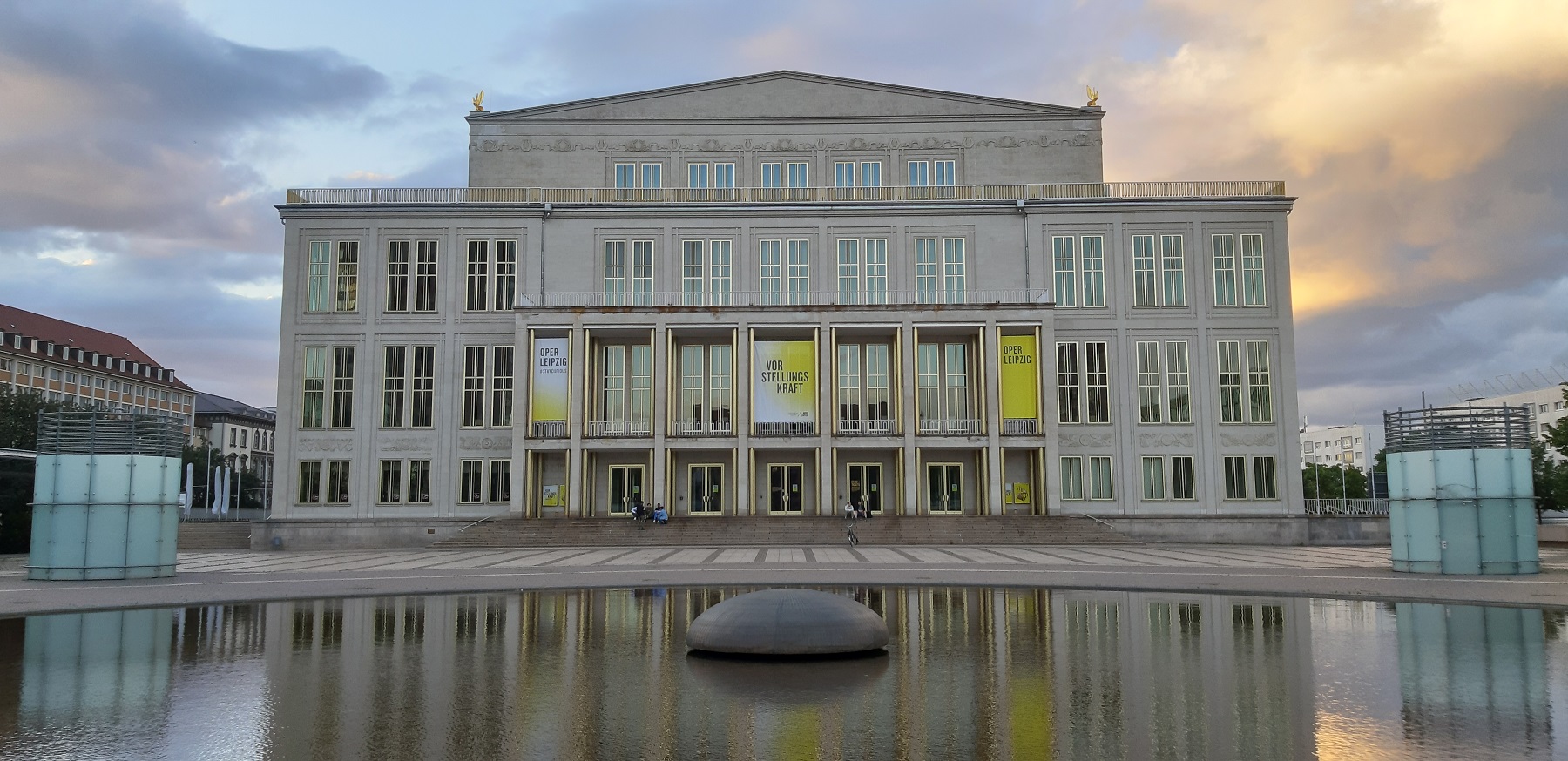
Opernhaus is the name of Leipzig’s opera house, and it is one of the city’s leading cultural institutions. The opera house stands centrally on Augustusplatz, the city’s largest square, and this underlines the prestige of the opera. The current building was built in neoclassicism in the GDR era from 1954-1960 according to drawings by the architects Kunz Nierade and Kurt Hemmerling.
Previously, the Neue Theater stood on the same site as the current Opernhaus. It was designed by the classicist architect Carl Ferdinand Langhans and built in 1868. The Neue Theater was destroyed by an Allied air raid in December 1943, and seven years later the GDR Council of Ministers decided to demolish the ruins of the theater to build an opera house instead. When it opened, it featured a week-long performance of works by Richard Wagner.
Museum der Bildenden Künste is an art museum where you can see a large art collection that chronologically features works from the Middle Ages to modern times. Among other things, you can see paintings and sculptures, and here are works by Frans Hals, Casper David Friedrich and many others. At the museum you can also see a lot of modern art, and this is where Max Klinger’s famous statue of the composer Ludwig van Beethoven stands.
The history of the museum started in 1837, when the Leipziger Kunstverein was formed as an association with the aim of opening an art museum in the city. It happened in 1848 with the establishment of the Städtische Museum, where you could see contemporary art. In the following years, more collections were donated, and in 1853 Adolf Ber donated his collection to the city on the condition that a public art museum be built within five years. The city succeeded and was able to open the city’s new art museum in Ludwig Lange’s Italian Renaissance building on Augustusplatz in 1858.
The stately museum building was expanded several times as the collections at the Städtische Museum grew. During World War II, however, the museum was bombed by Great Britain, and thereafter the preserved art collection was displayed at several addresses in Leipzig over the decades. It took 61 years from the bombing before the current museum building in modern architecture was inaugurated in 2004.
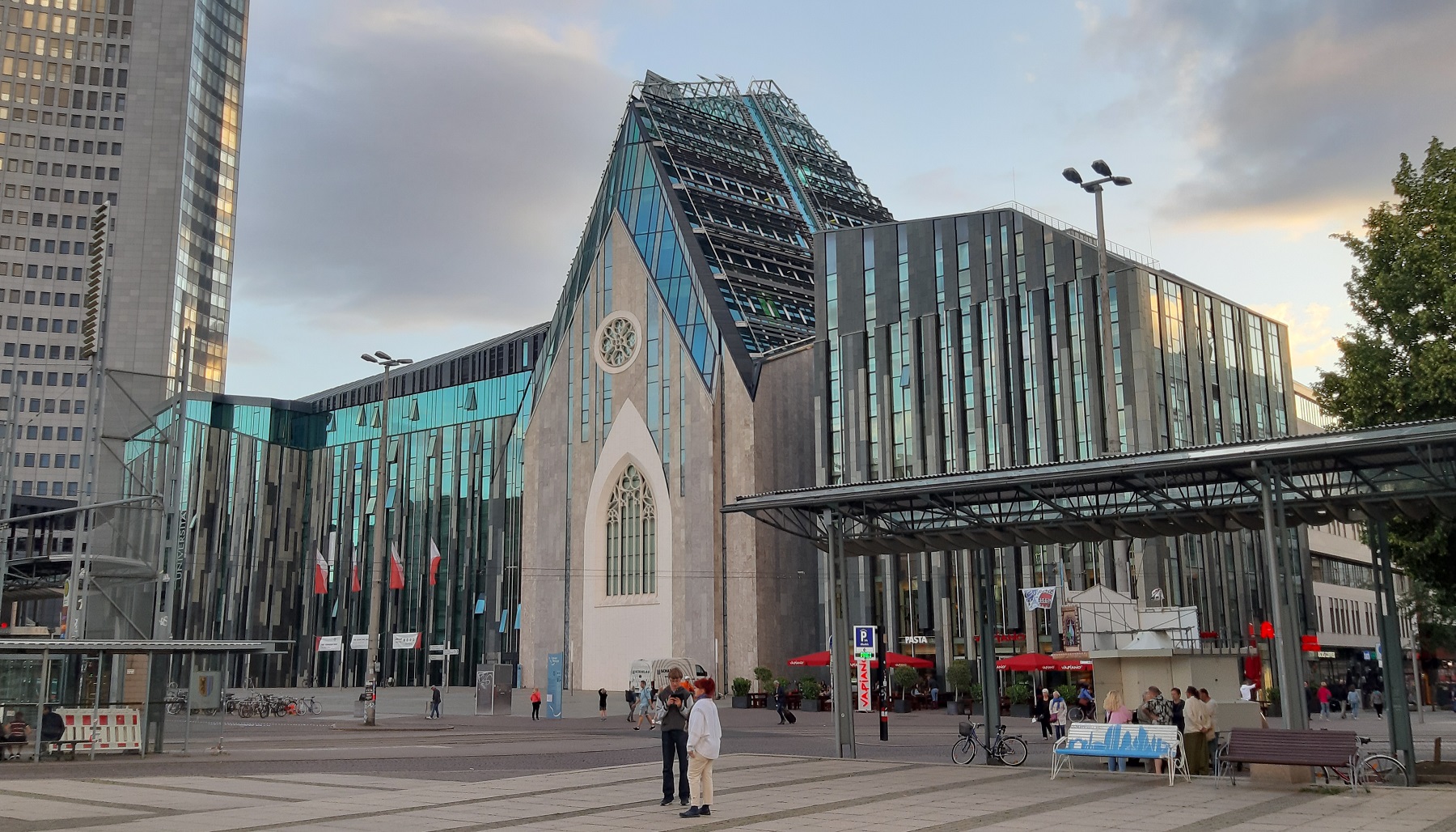
Paulinum is an exciting architectural feature in Leipzig’s cityscape, which can be seen on Augustusplatz square. It is a university building belonging to the University of Leipzig, which combines halls for the institutes of the educational institution and the old tradition of having a university church attached. The construction took place between 2007 and 2017 according to the design of the Dutch architect Erick van Egeraat.
When you stand on Augustusplatz, you can see the university’s modern facades, of which the Paulinum looks like a church gable from the outside. Next to the Paulinum, you can see the Augusteum in the connected building, which is the main building of the University of Leipzig. Before 1968, the Paulinerkirche and the former Augusteum were located on these sites, but that year the GDR government chose to demolish the otherwise preserved buildings in order to build a new university building in period architecture from the 1970s.
They later chose to demolish the building from the GDR-era Karl-Marx-University and replace it with the current buildings. They are new buildings, but behind the Augusteum you can see the Schinkeltor gate, which is the only preserved part of the university’s original 19th-century building.
In the 13th century, the Dominican monastery of St. Pauli was established on the site, and the monastery church was consecrated in 1240. The Paulinerkirche was later expanded, and from 1543 it functioned as the church of Leipzig University, which also used the church as the institution’s main auditorium. This is still the case with the newly built Paulinum, which contains both an auditorium, teaching rooms and a church.
Zum Arabischen Coffe Baum is the name of a famous café and museum in Leipzig. The coffee house is the second oldest in Europe, and coffee has been served here since 1711. The café is open in an atmospheric and historic setting, and you can also visit a coffee museum, where you can see exhibits from 300 years of Saxon coffee culture. Here there are, among other things, coffee grinders, Meissen porcelain, roasting equipment and coffee preparation vessels.
Several celebrities have visited the café regularly over time. One of these was, for example, the composer Robert Schumann, who was a regular visitor here for a number of years. There have also been many other celebrities passing by Zum Arabischen Coffe Baum such as Napoleon Bonaparte, August the Strong, Johann Wolfgang von Goethe, Richard Wagner and Gustav Mahler. Today, the café is furnished with the Kaisersaal, Schumann-Zimmer and other rooms.
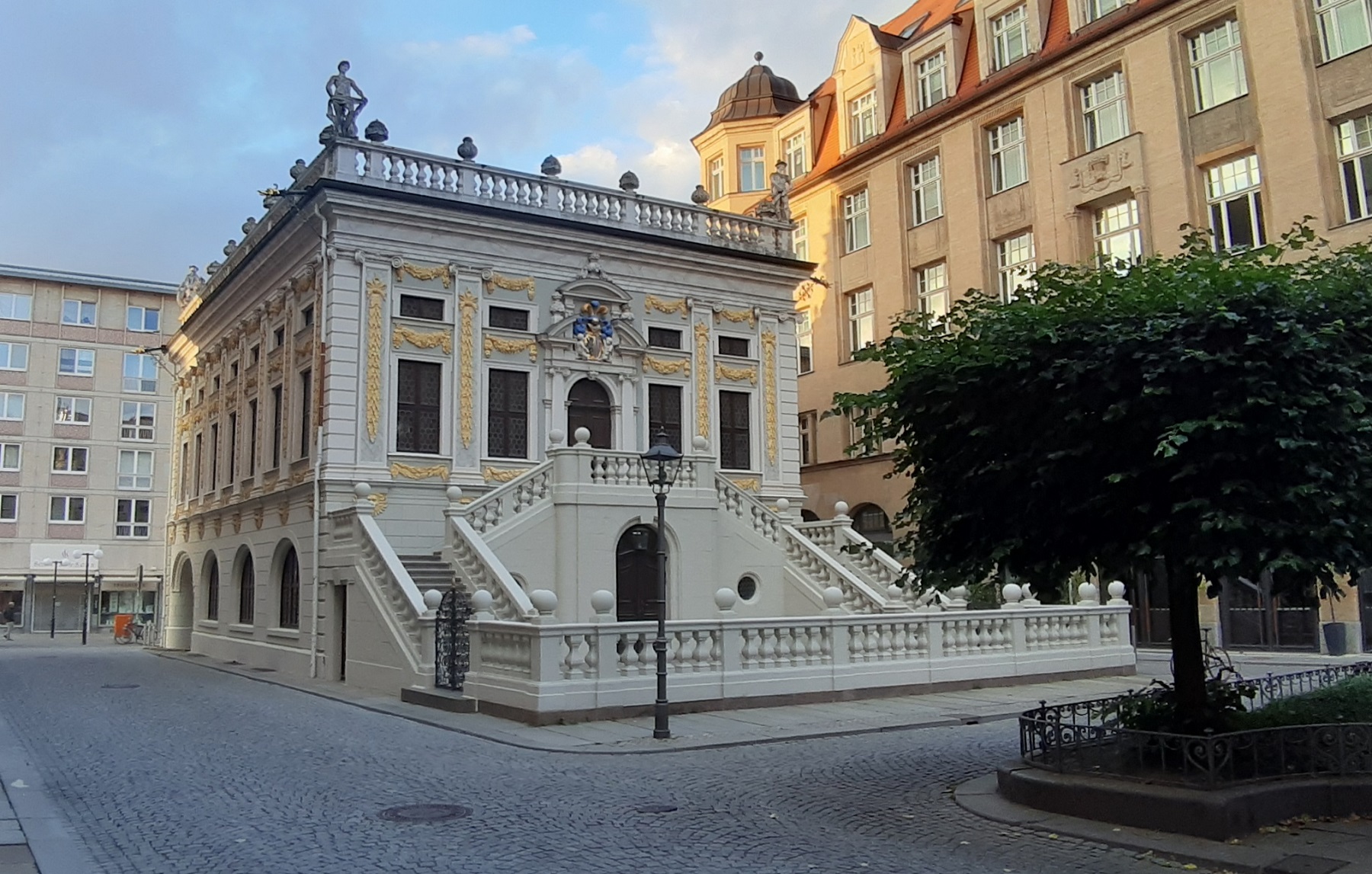
Alte Handelsbörse is a beautiful house that was built 1678-1687 as a meeting place for the city’s merchants. The stock exchange building was also built as Leipzig’s first Baroque building, and it opened with a stock exchange hall on the first floor and various rooms on the ground floor. Leipzig has always been an important trade center on two historical trade routes, and hence the initiative to build a stock exchange as a neutral exchange place to conduct business and execute trades. The plans appeared in 1667, and the city council decided on the construction in 1678.
The building is believed to have been designed by Johann Georg Starcke, who was the architect to the Elector of Saxony. The stock exchange was expanded in 1816 and replaced by Leipzig’s new and larger stock exchange in 1886. Later, the building was restored to its original appearance, but unfortunately it had to be rebuilt after destruction during the Second World War. Today, the elegant baroque building is used for a number of different purposes, such as musical and literary events, lectures, conferences and festive events.
St. Trinitatis Kirche is a church, also called Propsteikirche, and it belongs to the Leipzig Catholic congregation. The church was inaugurated in 2015 with a very simple and stylish church space. The church is the third Trinitatis Kirche in the city. The first was built in 1847 and destroyed during World War II before being blown up in 1954. The second church was built in modern architecture in 1982, but later demolished. The concrete church tower was preserved and can still be seen, however, the church was located a little to the north-west of the present church.
The church from 2015 is an experience in modern church architecture, and it is worth seeing both externally and in the interior. The impression in the streetscape stands as an exciting contrast to, for example, Leipzig’s town hall, and in the church courtyard you are completely enclosed in the design. The same applies in the church room, with a clarity and elegance that provides a unique spatial experience with indirect daylight, which falls on the back wall of the altar.
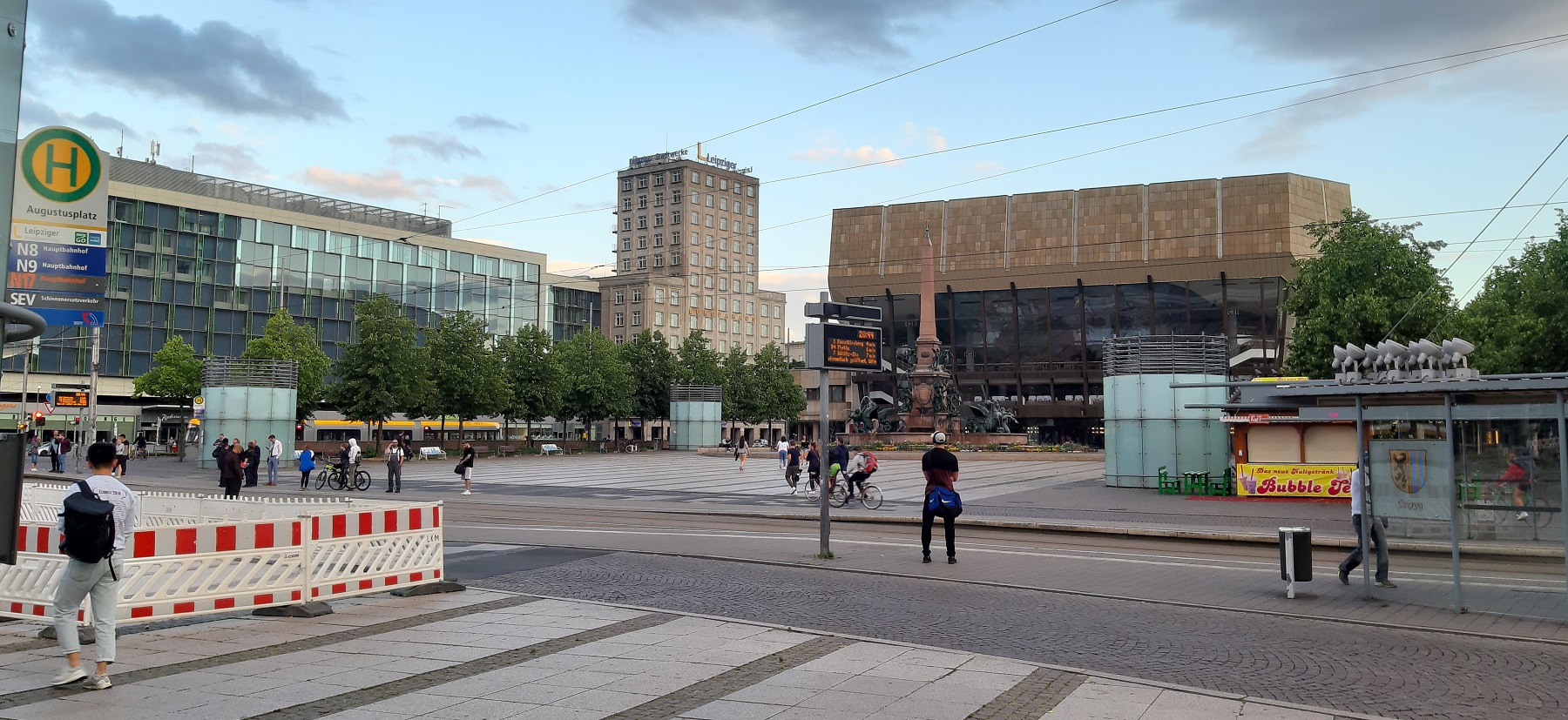
Augustusplatz is one of Germany’s largest squares, and many of Leipzig’s well-known buildings are located on and around it. The square was laid out from 1785 to a design by the city architect Johann Carl Friedrich Dauthe. The square was initially called Platz vor dem Grimmaischen Tor, and it got its current name in 1839. The name Augustusplatz comes from the Saxony king Friedrich August I. The square changed its name several times throughout the 20th century as well.
The city government renamed it Karl-Marx-Platz in 1928, the Nazis reverted the name in 1933, before the GDR government again named it Karl-Marx-Platz, before the square became Augustusplatz again in 1990. The square is dominated by the Leipzig Opera House to the north and the Gewandhaus concert hall to the south. In front of the Gewandhaus, you can see the fountain Mendebrunnen from 1886. You can also see the architecturally interesting building Paulinum and the high-rise City-Hochhaus around the square.
Gewandhaus is a modern concert building, which was inaugurated in 1981 after a design by Rudolf Skoda. It was the conductor Kurt Masur who laid the foundation stone for the building in 1977. The Gewandhaus is a house with a beautiful concert hall and a nice lobby with an impressive painting in the ceiling that gives a good visual effect from Augustusplatz. The Gewandhaus is also home to the well-known Gewandhaus Orchestra and known for its fine acoustics.
The current building is the third edition of the Gewandhaus. The first was built in 1781 by the architect Johann Carl Friedrich Dauthe, and it was the stage for premieres of many famous works such as Ludwig van Beethoven’s Piano Concerto No. 5 in 1811 and the overture to Richard Wagner’s Die Meistersinger von Nürnberg in 1862. The second Gewandhaus was designed by Martin Gropius and opened in 1884. After destruction during World War II, it was demolished in 1968.
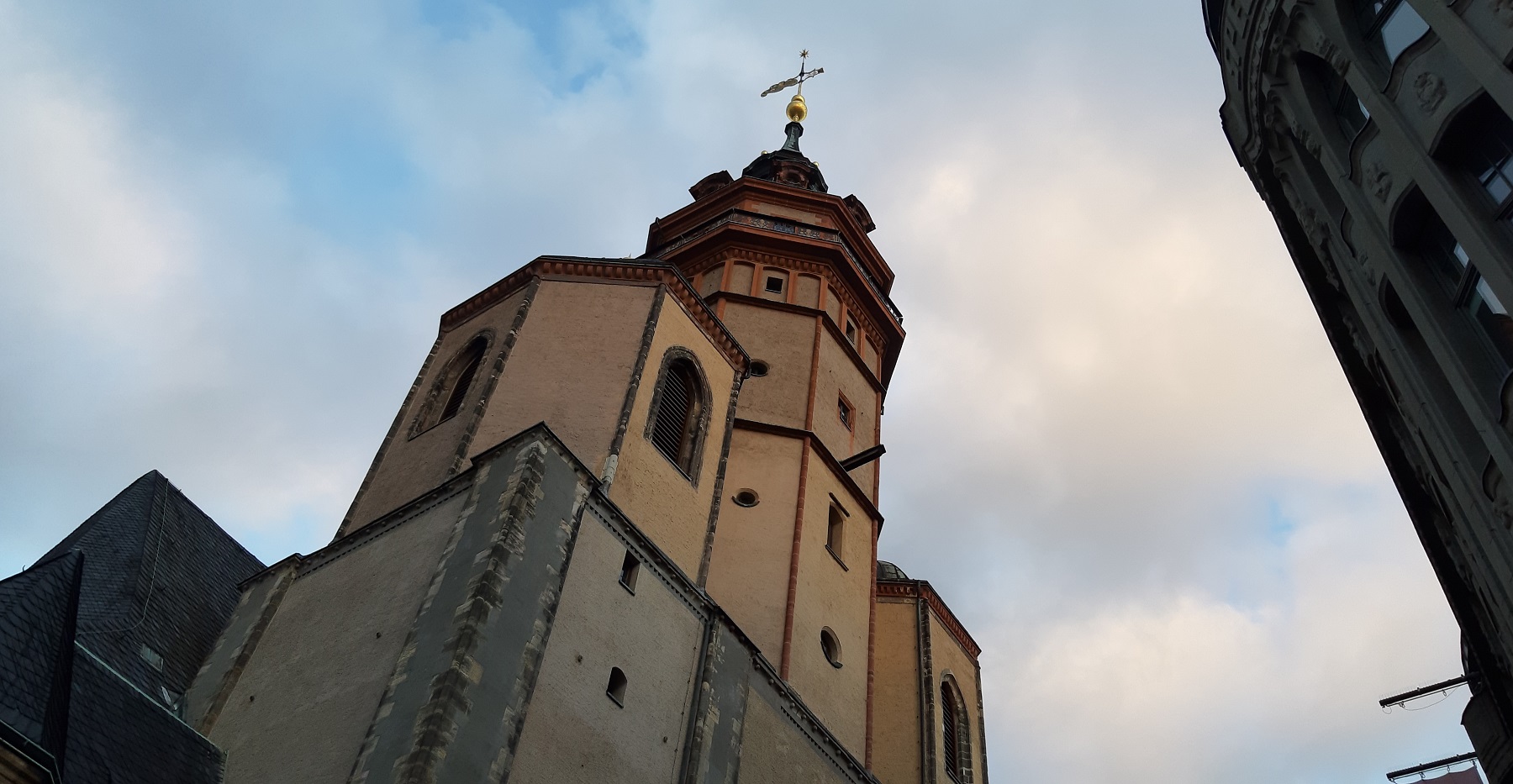
The Nikolaikirche is a church that was founded in 1165 and built in Romanesque style. Together with the Thomaskirche, it stands as Leipzig’s main churches. Nikolaikirche has been rebuilt and expanded over time, which most clearly happened in the 16th century, when the church was changed to a Gothic hall church. The baroque main tower was built in 1730, and the church’s entrance portal dates from 1759. The interior was decorated in neoclassicism in 1784-1797 by the architect Johann Carl Friedrich Dauthe, and his beautiful works still stand.
Nikolaikirche became known in 1989 as the place where the so-called Monday demonstrations took place. They were demonstrations for those who wanted changes in the GDR, and the protests against the government lasted from 4 September 1989 to 1991 in the church. Monday’s demonstrations spread to other places in the country, but those in the Nikolaikirche were the most well-known.
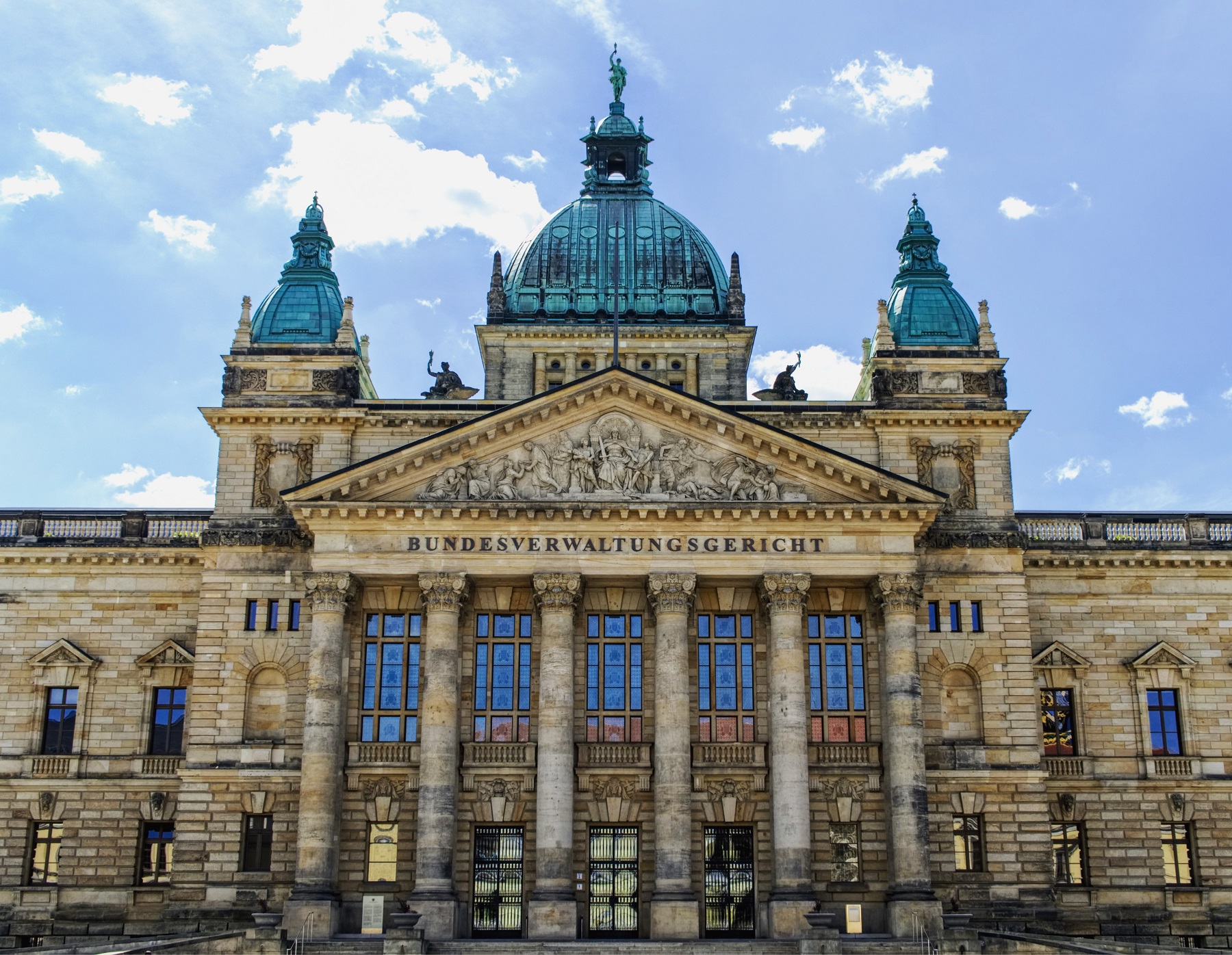
The Reichsgerichtsgebäude is one of Leipzig’s monumental buildings from the decades around year 1900. The impressive building was constructed 1888-1895 as the so-called Reichsgericht, which was a court in Imperial Germany. The large building complex was designed by Ludwig Hoffmann and Peter Dybwad, whose drawings were found to be the winner of an architectural competition held in 1884-1885.
The architecture of the Reichsgerichtsgebäude has several features from not least French Baroque and Italian late Renaissance. The central part of the building is crowned by a 68.5 meter high dome, with the sculpture Die Wahrheit or The Truth standing on top as a good symbol of the building’s function as a court. You can also see the six-columned portico with Justitia in the middle. On the building’s northern facade there are also sculptures of various well-known figures from German legal history.
Today you can visit the building and see the impressive Kuppelhalle and the beautifully decorated Große Sitzungssaal, which is a hall 23 meters long, 12 meters wide and almost 10 meters high. You can also see the Reichsgerichtsmuseum, which depicts the legal history of the building. The Reichsgerichtsgebäude was opened as a court building, but over time museums and various offices have also been located in the large building.
Panometer is the name of a huge gas storage facility that has been transformed into a fascinating exhibition space. After serving as a gas tank for many decades, Panometer opened as the world’s largest 360° panorama in 2003. In the round building, you can enjoy changing 32 meter high panoramic works on the inside of the old walls of the gas tank.
It was Yadegar Asisi who initiated Panometer, which is a contraction of the names panorama and gasometer. The gas tank was built in 1909 according to Hugo Licht’s drawings, and it was in use until 1977. The building has a diameter of 57 meters and a height of 49 meters, so there are large proportions for the fascinating panoramas.
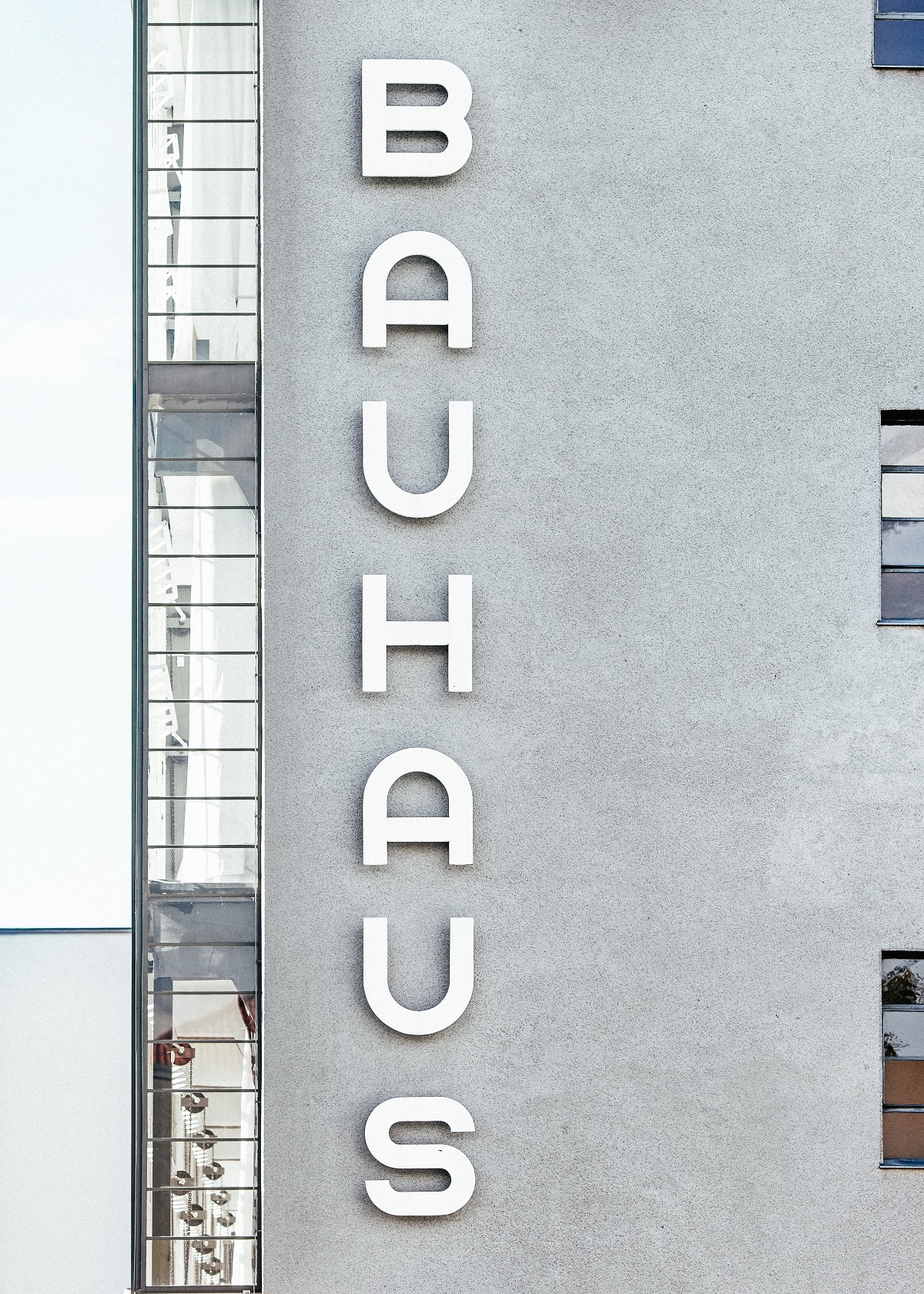
Bauhaus was a world-famous school of design and applied architecture that existed in the years 1919-1933. The school was founded by Walter Gropius in the city of Weimar, and it moved to Dessau in 1925 and was moved again to Berlin in 1932. Walter Gropius was the principal of the Bauhaus school from the beginning until 1928, and Hannes Meyer and then Ludwig Mies van der Rohe were the following principals.
It was the political climate in Germany that moved the school several times and thereby the Bauhaus activities. Criticism of the school’s modernist views meant that the school for political reasons and due to reduced funding, chose to move from the conservative Weimar to the social democratic Dessau in 1925. The Nazi regime in the city put an end to the Bauhaus in the city in 1932, after the party had won the local elections the year before. Mies van der Rohe moved the school to Berlin, but here too the school was closed by the political system.
Despite the closures, the Bauhaus school achieved fame and became one of the most influential institutions of modernism and functionalism. The graphic design and typography created at the Bauhaus also greatly influenced the development of modern graphic design. You can see more of this in Dessau, where you can visit the Bauhaus Museum Dessau.
The museum is located in the center of the city, where you can see the old Bauhaus school a little to the northwest, and in the southern suburb of Törten is an entire district created by Walter Gropius. You can also go to the northern part of the city, where the Elbe flows, and here you can see the Kornhaus, which is open as a restaurant.

Halle is one of the largest cities in the state of Saxony-Anhalt. It is located on the river Saale and was historically known for a large production of salt, which fed the city’s economy. Halle later became a member of the Hanseatic League, and in the 16th century the city became one of the important places for Martin Luther’s reformation. Today, Halle is the home of the educational institution Martin-Luther-Universität Halle-Wittenberg.
Halle is a city with many sights and a beautiful old quarter. The center is the square Marktplatz, and you can e.g. see the Marktkirche from the 16th century and the unique Roter Turm, which is the city’s landmark. Roter Turm was primarily built in the 15th century as a tower for a now historic church on the site. As a detail, you can see Halle’s Roland statue at the Roter Turm, and the city’s beautiful town hall is also located on the Marktplatz.
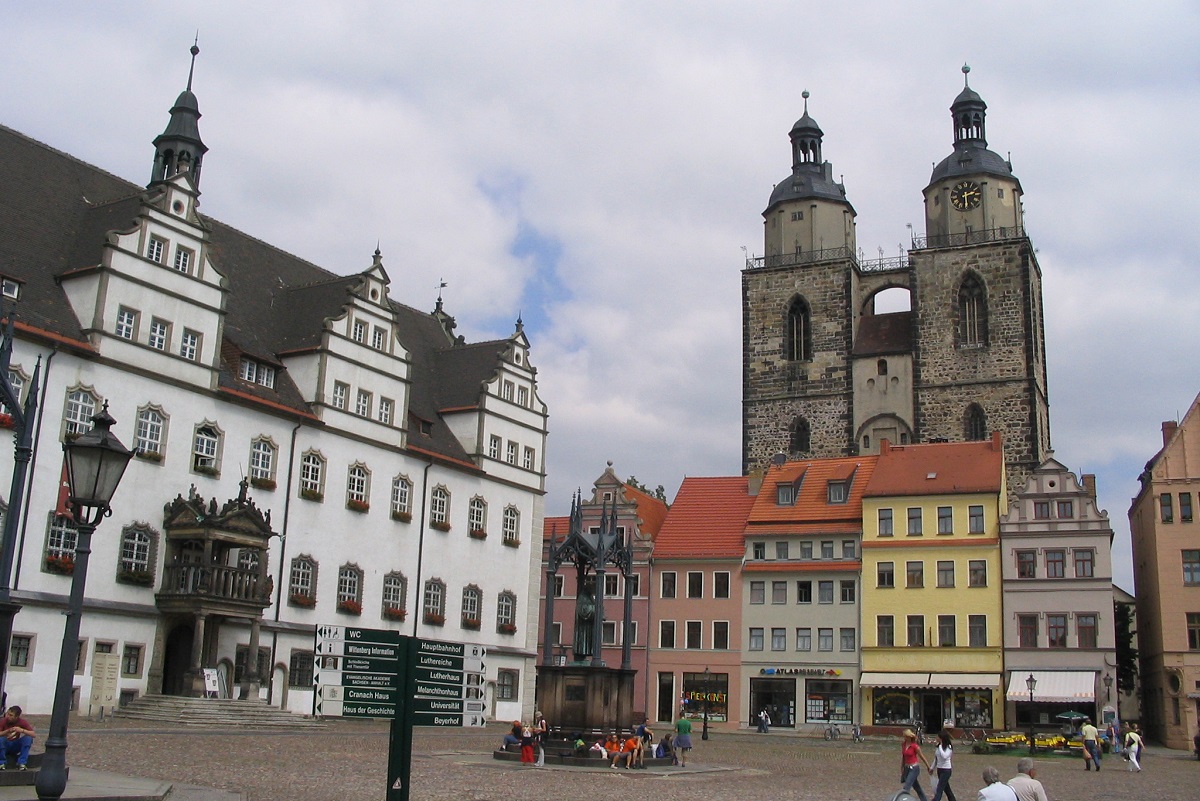
Wittenberg is a city located on the banks of the Elbe. It was mentioned in 1180, and in 1260 it became the residence of the Dukes of Saxony-Wittenberg. In the following centuries, Wittenberg became an important trading town, and from the end of the 15th century the Electors of Saxony made new developments. The best example was Frederik III’s founding of Wittenberg University in 1502. The university attracted people from outside town, and one of them was Martin Luther.
Martin Luther became a professor at the university, and he developed theological views on, among other things, the church and man’s relationship with God. One of the decisive points for him was the Catholic Church’s use of indulgences. Luther distanced himself from the indulgences and the teaching about the role of the pope and the councils, and in doing so he triggered the Reformation over the years, which separated the Protestant churches from the Catholic.
Luther formulated his views in 95 theses, which he posted on the door of the Schlosskirche church. The theses had also been sent to Albrecht of Brandenburg and the Bishop of Brandenburg, but Martin Luther also posted them on the church door to start an academic discussion. The diplomat Christoph Scheurl translated the theses into German and published them, and they spread in Germany and Europe at fast pace.
Wittenberg became world-renowned as the place where the Reformation started, and there are several sights in the city. The Schlosskirche was built 1496-1506, and it was here that Luther posted his theses in 1517. The church’s original door has not been preserved, but you can see the the Theses Door, which was inserted in 1858. The church is worth seeing, and in the interior you can see Martin Luther’s grave as one of the highlights. The Schlosskirche is today included in the UNESCO World Heritage List.
You can also see the Lutherhaus, which was Martin Luther’s residence and place of study in the years before and after the Reformation. Today, the house is a museum, where you can see several belongings and objects from Luther’s life and deeds. The Lutherhaus was built in 1504 as part of Wittenberg’s university, and on a tour you can see some of the interior, such as the Lutherstube living room.

Magdeburg is a city beautifully located on the banks of the Elbe river and it is a city with many attractions, beautiful parks and a rich history that can be seen and explored several places in the centre. The city is of course also known for the Magdeburg Rights, which were a collection of city laws with a great influence on the governance of many European cities.
The cathedral dominates Magdeburg’s skyline and is one of the city’s most famous buildings. The church was founded by the Holy Roman Emperor Otto I, who is today buried in the cathedral. He established Magdeburg as what is popularly said to be the first capital of the German territory, and it boosted the city over the centuries.
There are several old churches and monasteries in Magdeburg, which is also characterized by beautiful and interesting buildings from more recent times. You can see many examples from the Gründerzeit era and from the GDR’s magnificent 1950s architecture. It is also in Magdeburg that you can enjoy Friedensreich Hundertwasser’s last project, Grüne Zitadelle.
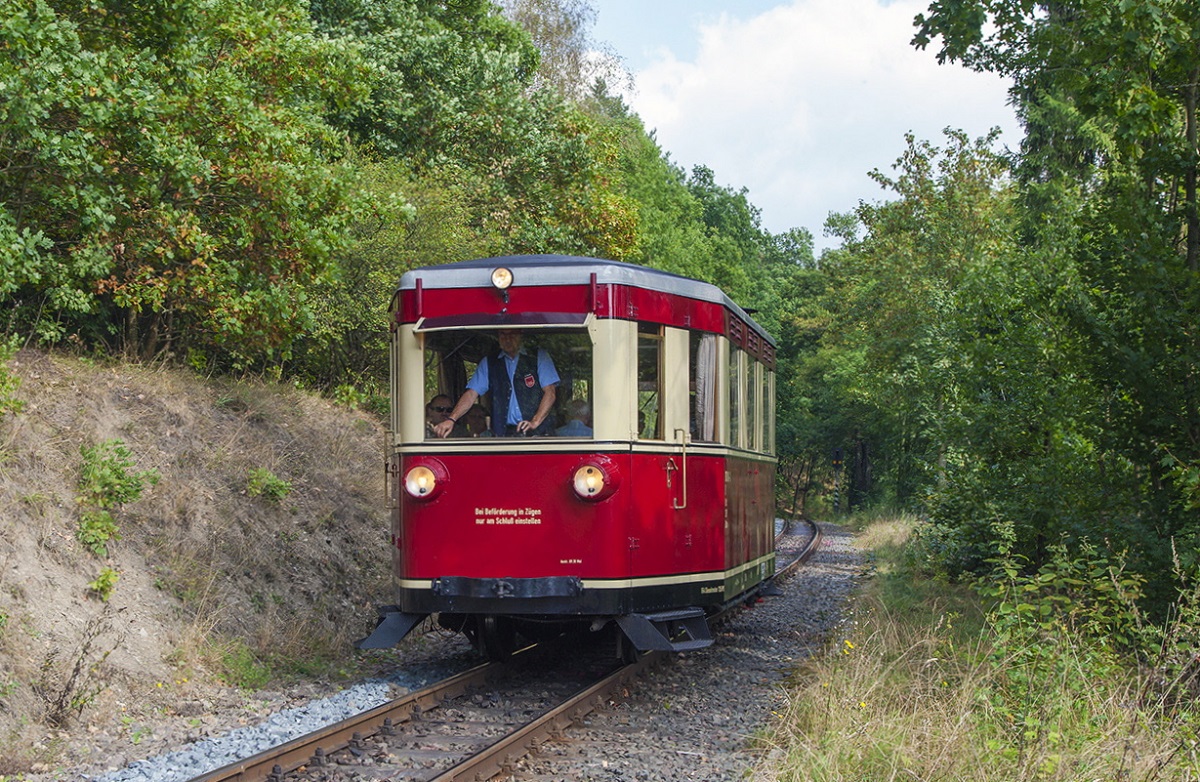
Quedlinburg is a town located immediately north of the Harz mountain range. The city has existed since at least 922, when it was mentioned the first time. According to legend, Heinrich der Vogler was offered the German crown in Quedlinburg in 919. Heinrich also founded the town’s castle, which Emperor Otto expanded later that century. Quedlinburg grew and it became a member of the Hanseatic League in 1426. The beautiful old town center was built with many half-timbered houses, and it has been included in the UNESCO World Heritage List.
Today, Quedlinburg is one of the nicest and best-preserved towns of its kind. You can see everything from half-timbered houses from many centuries to examples of Art Nouveau from the decades around 1900. The oldest of the countless half-timbered houses is the Ständerbau from 1347, and you can also see the Klopstockhaus from 1570, where the poet Friedrich Gottlieb Klopstock was born in 1724. In the center you should walk to the central Quedlinburger Marktplatz, where you can see the city’s town hall, among other things.
Another highlight of Quedlinburg is literally the hill Schlossberg, where the famous Stiftskirche St. Servatius church is located next to the city’s castle. St. Servatius is the city’s cathedral, and it mainly dates from 1070-1124. At the castle, you can visit the Schlossmuseum, where you can see the stately rooms and exhibitions about the historic Quedlinburg. Heinrich der Vogler is also buried in Stift Quedlinburg.
You can also go to Quedlinburg’s fine railway station, which is a good starting point for trips on the narrow-gauge railways that form the Harzer Schmalspurbahnen. From Quedlinburg you can take the Selketalbahn to, for example, the interesting town of Harzgerode or to Eisfelder Talmühle, where you can change to the Harzquerbahn. It is a railway that you can take to Wernigerode or Drei Annen Hohne, and from here you can take the Brockenbahn to Brocken, which at 1,141 meters is the highest point in the Harz mountain range.

Erfurt is located on the river Gera and is the capital of the German state of Thuringia. It is an old town that was mentioned already from the 8th century. Later, the city temporarily became the home of Martin Luther, who was a priest in Erfurt’s cathedral before he moved to Wittenberg. Later, Erfurt became historic when the first meeting between government leaders from the GDR and West Germany took place at the Hotel Erfurter Hof in 1970.
The old town of Erfurt, Altstadt, is one of the best-preserved medieval towns in Germany, and there are many sights in the cozy streets. One of the best-known is the Krämerbrücke, a bridge from 1325 built with half-timbered houses on both sides of the cobblestoned road in the middle. Immediately west of the Krämerbrücke you can see the Alte Synagoge, which like the bridge also dates from around 1300.
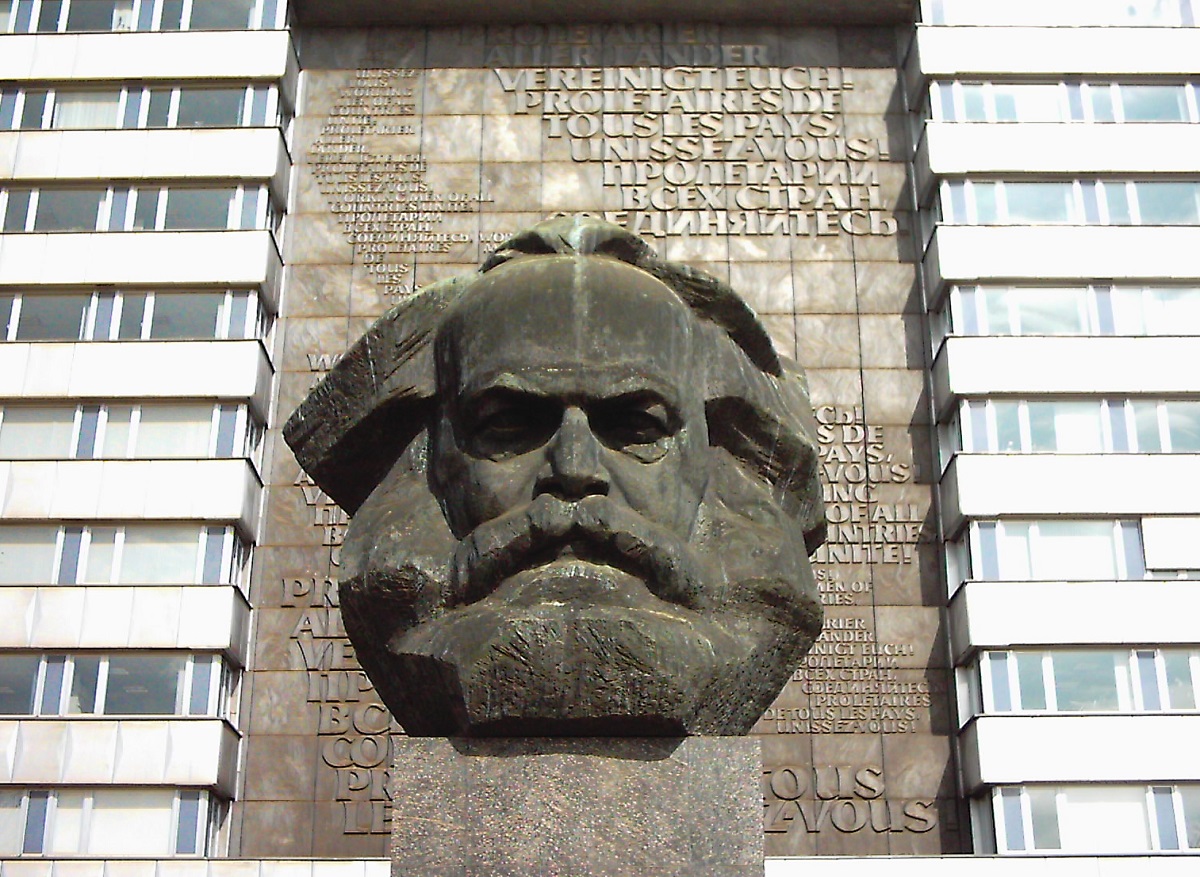
Chemnitz is the third largest city in the state of Saxony. Its name comes from the Sorbian word for a rocky place, Kamjenica, but the town has not always been called Chemnitz. In the years 1953-1990, in the East German era, the city was named Karl-Marx-Stadt in memory of Karl Marx, who was one of the fathers of communism and thereby the GDR. As a large industrial city, there were also members of the German Communist Party in Chemnitz early in the 20th century.
Because of Chemnitz’s large industry, large parts of the city were destroyed by bombing during World War II. This gave the new government in the GDR the opportunity to rebuild the city as a model city based on socialist urban planning. By and large, the city was built according to these plans, and thus both the center and suburbs are characterized by modern buildings, and in the center stands a monument to Karl Marx.
Neumarkt 1
galeria-kaufhof.de
Brühl 1
hoefe-am-bruehl.de
Grimmaische Straße 2-4
maedlerpassage.de
Willy-Brandt-Platz 7
promenaden-hauptbahnhof-leipzig.de
Grimmaische Straße, Brühl, Markt, Neumarkt, Peterstraße
Unikatum Kindermuseum
Zschochersche Straße 26
kindermuseum-unikatum.de
Schreberbad
Schreberstraße 15
l.de/schreberbad
Puppentheater Sterntaler
Talstraße 30
puppentheater-sterntaler.de
Zoo Leipzig
Pfaffendorfer Straße 29
zoo-leipzig.de
Parkeisenbahn Auensee
Gustav-Esche-Straße 8
parkeisenbahn-auensee-leipzig.de
Naturkundemuseum
Lortzingstraße 3
naturkundemuseum.leipzig.de
Belantis
Zur Weißen Mark 1
belantis.de

Bundesverwaltungsgericht, LeipzigOverview of Leipzig
Leipzig is a city with long and proud traditions in trade. It was here that the trade routes Via Regia and Via Imperii crossed each other, thereby connecting most of Europe through Leipzig. Trade created a wealthy city, which for a period was also one of the European strongholds for culture and education.
There are many beautiful and impressive buildings in Leipzig, where you can enjoy architecture from many eras. The city’s old town hall stands as one of Germany’s finest Renaissance buildings, and you can also see fine examples from the Baroque and later architectural styles, not least from historicism.
In Leipzig you should visit the city’s two main churches, the Nikolaikirche and the Thomaskirche, and you can also see the Paulinum as an exciting mix of an old church and modern architecture. Markt is the city’s central square, and close to it is Augustusplatz with the Leipzig Opera. The city’s many arcades and passages are also distinctive features.
About the Whitehorse travel guide
Contents: Tours in the city + tours in the surrounding area
Published: Released soon
Author: Stig Albeck
Publisher: Vamados.com
Language: English
About the travel guide
The Whitehorse travel guide gives you an overview of the sights and activities of the Canadian city. Read about top sights and other sights, and get a tour guide with tour suggestions and detailed descriptions of all the city’s most important churches, monuments, mansions, museums, etc.
Whitehorse is waiting for you, and at vamados.com you can also find cheap flights and great deals on hotels for your trip. You just select your travel dates and then you get flight and accommodation suggestions in and around the city.
Read more about Whitehorse and Canada
Canada Travel Guide: https://vamados.com/canada
City tourism: https://visitwhite-horse.ca
Main Page: https://www.vamados.com/
Buy the travel guide
Click the “Add to Cart” button to purchase the travel guide. After that you will come to the payment, where you enter the purchase and payment information. Upon payment of the travel guide, you will immediately receive a receipt with a link to download your purchase. You can download the travel guide immediately or use the download link in the email later.
Use the travel guide
When you buy the travel guide to Whitehorse you get the book online so you can have it on your phone, tablet or computer – and of course you can choose to print it. Use the maps and tour suggestions and you will have a good and content-rich journey.


Opernhaus is the name of Leipzig’s opera house, and it is one of the city’s leading cultural institutions. The opera house stands centrally on Augustusplatz, the city’s largest square, and this underlines the prestige of the opera. The current building was built in neoclassicism in the GDR era from 1954-1960 according to drawings by the architects Kunz Nierade and Kurt Hemmerling.
Previously, the Neue Theater stood on the same site as the current Opernhaus. It was designed by the classicist architect Carl Ferdinand Langhans and built in 1868. The Neue Theater was destroyed by an Allied air raid in December 1943, and seven years later the GDR Council of Ministers decided to demolish the ruins of the theater to build an opera house instead. When it opened, it featured a week-long performance of works by Richard Wagner.
Museum der Bildenden Künste is an art museum where you can see a large art collection that chronologically features works from the Middle Ages to modern times. Among other things, you can see paintings and sculptures, and here are works by Frans Hals, Casper David Friedrich and many others. At the museum you can also see a lot of modern art, and this is where Max Klinger’s famous statue of the composer Ludwig van Beethoven stands.
The history of the museum started in 1837, when the Leipziger Kunstverein was formed as an association with the aim of opening an art museum in the city. It happened in 1848 with the establishment of the Städtische Museum, where you could see contemporary art. In the following years, more collections were donated, and in 1853 Adolf Ber donated his collection to the city on the condition that a public art museum be built within five years. The city succeeded and was able to open the city’s new art museum in Ludwig Lange’s Italian Renaissance building on Augustusplatz in 1858.
The stately museum building was expanded several times as the collections at the Städtische Museum grew. During World War II, however, the museum was bombed by Great Britain, and thereafter the preserved art collection was displayed at several addresses in Leipzig over the decades. It took 61 years from the bombing before the current museum building in modern architecture was inaugurated in 2004.

Paulinum is an exciting architectural feature in Leipzig’s cityscape, which can be seen on Augustusplatz square. It is a university building belonging to the University of Leipzig, which combines halls for the institutes of the educational institution and the old tradition of having a university church attached. The construction took place between 2007 and 2017 according to the design of the Dutch architect Erick van Egeraat.
When you stand on Augustusplatz, you can see the university’s modern facades, of which the Paulinum looks like a church gable from the outside. Next to the Paulinum, you can see the Augusteum in the connected building, which is the main building of the University of Leipzig. Before 1968, the Paulinerkirche and the former Augusteum were located on these sites, but that year the GDR government chose to demolish the otherwise preserved buildings in order to build a new university building in period architecture from the 1970s.
They later chose to demolish the building from the GDR-era Karl-Marx-University and replace it with the current buildings. They are new buildings, but behind the Augusteum you can see the Schinkeltor gate, which is the only preserved part of the university’s original 19th-century building.
In the 13th century, the Dominican monastery of St. Pauli was established on the site, and the monastery church was consecrated in 1240. The Paulinerkirche was later expanded, and from 1543 it functioned as the church of Leipzig University, which also used the church as the institution’s main auditorium. This is still the case with the newly built Paulinum, which contains both an auditorium, teaching rooms and a church.
Zum Arabischen Coffe Baum is the name of a famous café and museum in Leipzig. The coffee house is the second oldest in Europe, and coffee has been served here since 1711. The café is open in an atmospheric and historic setting, and you can also visit a coffee museum, where you can see exhibits from 300 years of Saxon coffee culture. Here there are, among other things, coffee grinders, Meissen porcelain, roasting equipment and coffee preparation vessels.
Several celebrities have visited the café regularly over time. One of these was, for example, the composer Robert Schumann, who was a regular visitor here for a number of years. There have also been many other celebrities passing by Zum Arabischen Coffe Baum such as Napoleon Bonaparte, August the Strong, Johann Wolfgang von Goethe, Richard Wagner and Gustav Mahler. Today, the café is furnished with the Kaisersaal, Schumann-Zimmer and other rooms.

Alte Handelsbörse is a beautiful house that was built 1678-1687 as a meeting place for the city’s merchants. The stock exchange building was also built as Leipzig’s first Baroque building, and it opened with a stock exchange hall on the first floor and various rooms on the ground floor. Leipzig has always been an important trade center on two historical trade routes, and hence the initiative to build a stock exchange as a neutral exchange place to conduct business and execute trades. The plans appeared in 1667, and the city council decided on the construction in 1678.
The building is believed to have been designed by Johann Georg Starcke, who was the architect to the Elector of Saxony. The stock exchange was expanded in 1816 and replaced by Leipzig’s new and larger stock exchange in 1886. Later, the building was restored to its original appearance, but unfortunately it had to be rebuilt after destruction during the Second World War. Today, the elegant baroque building is used for a number of different purposes, such as musical and literary events, lectures, conferences and festive events.
St. Trinitatis Kirche is a church, also called Propsteikirche, and it belongs to the Leipzig Catholic congregation. The church was inaugurated in 2015 with a very simple and stylish church space. The church is the third Trinitatis Kirche in the city. The first was built in 1847 and destroyed during World War II before being blown up in 1954. The second church was built in modern architecture in 1982, but later demolished. The concrete church tower was preserved and can still be seen, however, the church was located a little to the north-west of the present church.
The church from 2015 is an experience in modern church architecture, and it is worth seeing both externally and in the interior. The impression in the streetscape stands as an exciting contrast to, for example, Leipzig’s town hall, and in the church courtyard you are completely enclosed in the design. The same applies in the church room, with a clarity and elegance that provides a unique spatial experience with indirect daylight, which falls on the back wall of the altar.

Augustusplatz is one of Germany’s largest squares, and many of Leipzig’s well-known buildings are located on and around it. The square was laid out from 1785 to a design by the city architect Johann Carl Friedrich Dauthe. The square was initially called Platz vor dem Grimmaischen Tor, and it got its current name in 1839. The name Augustusplatz comes from the Saxony king Friedrich August I. The square changed its name several times throughout the 20th century as well.
The city government renamed it Karl-Marx-Platz in 1928, the Nazis reverted the name in 1933, before the GDR government again named it Karl-Marx-Platz, before the square became Augustusplatz again in 1990. The square is dominated by the Leipzig Opera House to the north and the Gewandhaus concert hall to the south. In front of the Gewandhaus, you can see the fountain Mendebrunnen from 1886. You can also see the architecturally interesting building Paulinum and the high-rise City-Hochhaus around the square.
Gewandhaus is a modern concert building, which was inaugurated in 1981 after a design by Rudolf Skoda. It was the conductor Kurt Masur who laid the foundation stone for the building in 1977. The Gewandhaus is a house with a beautiful concert hall and a nice lobby with an impressive painting in the ceiling that gives a good visual effect from Augustusplatz. The Gewandhaus is also home to the well-known Gewandhaus Orchestra and known for its fine acoustics.
The current building is the third edition of the Gewandhaus. The first was built in 1781 by the architect Johann Carl Friedrich Dauthe, and it was the stage for premieres of many famous works such as Ludwig van Beethoven’s Piano Concerto No. 5 in 1811 and the overture to Richard Wagner’s Die Meistersinger von Nürnberg in 1862. The second Gewandhaus was designed by Martin Gropius and opened in 1884. After destruction during World War II, it was demolished in 1968.

The Nikolaikirche is a church that was founded in 1165 and built in Romanesque style. Together with the Thomaskirche, it stands as Leipzig’s main churches. Nikolaikirche has been rebuilt and expanded over time, which most clearly happened in the 16th century, when the church was changed to a Gothic hall church. The baroque main tower was built in 1730, and the church’s entrance portal dates from 1759. The interior was decorated in neoclassicism in 1784-1797 by the architect Johann Carl Friedrich Dauthe, and his beautiful works still stand.
Nikolaikirche became known in 1989 as the place where the so-called Monday demonstrations took place. They were demonstrations for those who wanted changes in the GDR, and the protests against the government lasted from 4 September 1989 to 1991 in the church. Monday’s demonstrations spread to other places in the country, but those in the Nikolaikirche were the most well-known.

The Reichsgerichtsgebäude is one of Leipzig’s monumental buildings from the decades around year 1900. The impressive building was constructed 1888-1895 as the so-called Reichsgericht, which was a court in Imperial Germany. The large building complex was designed by Ludwig Hoffmann and Peter Dybwad, whose drawings were found to be the winner of an architectural competition held in 1884-1885.
The architecture of the Reichsgerichtsgebäude has several features from not least French Baroque and Italian late Renaissance. The central part of the building is crowned by a 68.5 meter high dome, with the sculpture Die Wahrheit or The Truth standing on top as a good symbol of the building’s function as a court. You can also see the six-columned portico with Justitia in the middle. On the building’s northern facade there are also sculptures of various well-known figures from German legal history.
Today you can visit the building and see the impressive Kuppelhalle and the beautifully decorated Große Sitzungssaal, which is a hall 23 meters long, 12 meters wide and almost 10 meters high. You can also see the Reichsgerichtsmuseum, which depicts the legal history of the building. The Reichsgerichtsgebäude was opened as a court building, but over time museums and various offices have also been located in the large building.
Panometer is the name of a huge gas storage facility that has been transformed into a fascinating exhibition space. After serving as a gas tank for many decades, Panometer opened as the world’s largest 360° panorama in 2003. In the round building, you can enjoy changing 32 meter high panoramic works on the inside of the old walls of the gas tank.
It was Yadegar Asisi who initiated Panometer, which is a contraction of the names panorama and gasometer. The gas tank was built in 1909 according to Hugo Licht’s drawings, and it was in use until 1977. The building has a diameter of 57 meters and a height of 49 meters, so there are large proportions for the fascinating panoramas.
Similar to Leipzig Travel Guide
